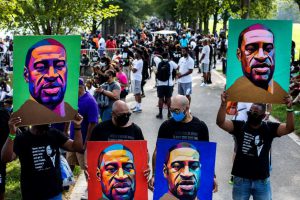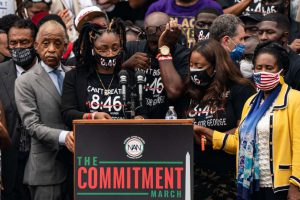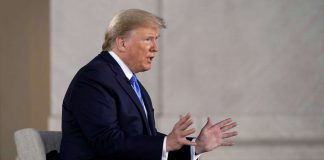AUGUST 29, 2020

Protesters greet each other while holding George Floyd posters at the Lincoln Memorial Friday.
Just past dawn Friday, more than a half-century after the Rev. Martin Luther King Jr. stood on the Lincoln Memorial’s marble steps and offered his vision for a fair and righteous America, thousands of protesters descended on the nation’s capital at the end of a summer that has laid bare just how distant the fulfillment of his vision remains.
Among them was Marilyn Boddy, 62, who had never attended a protest. As a decades-long federal employee, Boddy had always been reluctant to join in public demonstrations, but that changed when she heard the Rev. Al Sharpton eulogize George Floyd, who died in May beneath the knee of a Minneapolis police officer.

“It was right there, in the emotion of that moment, that I knew I would be here today,” Boddy said, describing the anger and anguish that shot through her while watching the televised service from her New Jersey living room.
On Friday, 200 miles south, she wore a mask inscribed with “BLACK LIVES MATTER” and a red T-shirt featuring the same words, surrounded by the faces of 11 dead Black men and women: Floyd, Ahmaud Arbery, Trayvon Martin, Sandra Bland, Tamir Rice, Mike Brown, Eric Garner, Sean Bell, Jordan Davis, Rayshard Brooks and Breonna Taylor.
“We are sick and tired,” she said, surveying the crowd swelling behind her. “At this point, I’d crawl over glass to be here.”
It had been exactly 57 years since King spoke about his dream of unity but also warned, in words quoted far less often, that “the whirlwinds of revolt will continue to shake the foundations of our nation until the bright day of justice emerges.”
It had been three months since those foundations were shaken yet again, this time in the furious, fiery aftermath of Floyd’s killing.
It had been six weeks since the death of civil rights icon and Georgia congressman John Lewis, who had been the last living speaker at the original March on Washington — where the then-23-year-old had told the crowd, “We are tired — We are tired of being beaten by policemen.”
It had been five days since a Kenosha, Wis., officer shot Jacob Blake in the back, paralyzing him in front of his children.
It had been three days since, investigators say, a White teenage vigilante with an AR-15 gunned down two men who had confronted him on a night of chaotic protests in Kenosha.
It had been two days since the country’s greatest athletes refused to take courts and fields, to entertain a country that, to many of them, did not value their Black lives as much as White ones.
And it had been less than 24 hours since President Trump accepted the Republican Party’s nomination from the South Lawn of 1600 Pennsylvania Avenue, transforming “The People’s House” — fortified behind concrete barriers and high metal fences — into a campaign prop. Trump gave a speech laced with falsehoods to a tightly packed crowd of more than 1,500 people, almost none wearing masks in the middle of a pandemic.
“No one will be safe” in Joe Biden’s America, the president warned at the end of a week of extraordinary devastation in his America: Wildfires devoured homes in the West, a Category 4 hurricane leveled neighborhoods in the South, protesters lit buildings aflame in the Midwest and a still-raging pandemic took more American lives than were lost on 9/11, pushing the total death toll to at least 178,000.
Sharpton, who organized Friday’s “Get Your Knee Off Our Necks” March on Washington, took aim at Trump, his supporters and everyone else who ignore the country’s deeply rooted racism.
“For too long, you acted like we didn’t matter,” Sharpton declared from the steps of the Lincoln Memorial, directly addressing the country. “They say, ‘Well, everybody matters.’ But everybody hasn’t mattered the same in America. The reason we had and we still have to say ‘Black Lives Matter’ is because we get less health care, like we don’t matter. We go to jail longer for the same crimes, like we don’t matter . . . Black lives matter, and we won’t stop until it matters to everybody.”
What followed was a procession of anguished Black men and women whose loved ones had been killed or maimed in recent years. The line of grieving families ran so long that not all of them had a chance to speak.
Eric Garner Jr. led the crowd in a familiar chant — “I. Can’t. Breathe.” — and offered a reminder: “It’s been six years since my father’s words became our words.”
Ahmaud Arbery’s father, Marcus, shared the simplicity of what he missed: “I’m used to my boy calling me, saying he loves me. Sometimes I’m like, ‘He forgot to call me.’ ”
Trayvon Martin’s mother, Sybrina Fulton, pleaded for persistence: “Even though it looks dark, I want to tell you to be encouraged. . . . Stand up. We was built for this.”
Friday’s protest was one of contrasts — of messages of despair and of hope, of people asking, “How, after all these decades, are we still fighting for change?” while others declared, “This is the change.”
When David Queen Sr. heard months ago about the new March on Washington, he knew he would go.
Queen, 50, was born several years after the historic 1963 march that inspired Friday’s event. But he grew up steeped in the stories and symbolism of that day — and disappointed, repeatedly, that the social evils of that era refused to recede as he became an adult, and then a father.
“Some progress has been made. But we still have a long way to go,” Queen said as he stood on the Mall shortly before noon. Behind him, the Washington Monument speared into a hot, hazy August sky. “If you base it on freedom, I’d say we are 20 percent there.”
Standing beside Queen was his 32-year-old son, David Queen Jr. Like his father, he was born and raised in Baltimore. The pair had made the trip south, and masked themselves on a sweltering summer day, out of conviction that they needed to stand up for a better, more equitable future for African Americans.
What did the son expect of the country by the time he was his father’s age?
“Do you want to know what I think or what I hope?” he said, because what he expected fell far short of what he longed for.
Nearby, two Black brothers from Houston looked out over the same crowds and listened to the same speeches, but what they saw was progress, not failure. Instead of feeling discouraged by the police shooting of Jacob Blake or the killings at the Kenosha protest Tuesday, the Jones brothers had come to believe that the country was more united for racial change than ever.
They found proof in the number of companies that have spoken out and the professional sports teams that have boycotted games for the cause.
“It feels like, for the first time, there’s movement,” said Alford Jones, 64. “It’s so diverse. It’s not a Black movement. People are coming out from all over. You see it today. Injustice has no color.”
People of every age and race and from across the United States had descended on the mall from all directions, carrying messages on signs and on their sweat-soaked T-shirts: “Unbreakable,” said one. “B—-, don’t kill my tribe,” said another. “Good trouble,” read a tank top commemorating Lewis. One woman wore a dress that simply said: “Nah.”
By midday, the crowds stretched far beyond the area that required a temperature check to enter. Law enforcement was far more limited than it had been during the tense standoffs the city has seen this summer. Where military tanks had once blocked off streets, activists now saw D.C. garbage trucks. U.S. Park Police passed easily through the crowd gathered near the gates around the Lincoln. Satellite-topped TV trucks outnumbered police cruisers on 23rd Street NW.
Thousands lounged in the grass around the Vietnam Veterans Memorial, listening to speeches and slipping down their masks to sip water beneath the shade of American Elms. They cheered as speakers talked of Sen. Kamala D. Harris (D-Calif.), of American teachers, of the responsibility to vote. After the speeches, many activists marched to King’s granite statue and Black Lives Matter Plaza while others shut down streets and bridges as thunderstorms rolled in.
Before the rain, the crowd included hundreds of children, and though they couldn’t see beyond all the adults around them, the kids still tried to make sense of why they had all come.
“We are here so they can stop shooting us,” explained Malik Leak, age 11.
“White people are not happy that Black people are happy,” offered Rylee Bates Trenard, 9.
“The law is that you can’t attack an innocent Black man,” added Malcolm, also 9, as he scooped up a handful of Goldfish crackers. “It doesn’t make any sense. They know that, but they are still doing it.”
Sharilyn Wagner, 71, rested on a bench, thinking about Malik and Rylee and Malcolm’s generation as she fanned herself with a sign that said, “I don’t understand how you don’t understand.”
She had taken vacation from her job as a bus driver, flown from Austin to Baltimore, then paid $70 for a taxi to get here at 8 a.m.
“There were ones that have gone on and paved the way for us — Martin Luther King Jr. and John Lewis — but my generation hasn’t come that far,” Wagner said. “But I believe in this younger generation, oh, yes I do. I just know that the young people are going to take us where we need to be” — she pointed to a reporter’s phone — “with all that high tech and stuff.”
She watched the crowds pass by, noticing just how many of the young Black women were wearing braids. In 1978, she said, she was told she couldn’t wear her long braids while she worked as a bus driver. She had to remove them as she fought the rule through her union. She won.
On Friday, gray ringlet curls framed her Chanel mask as she listened to Martin Luther King III speak of dismantling “systemic racism, once and for all.” In 1963, when his father stood in the same spot, Wagner had been a student in a segregated middle school.
When she came home that day, she watched the speech on a small black-and-white TV. Her parents, who had grown up picking cotton, told her that man was “making good sense.”
Now she would have the chance to tell her children, grandchildren and great-grandchild about this day, when she heard a new vision for a just America that she hoped wouldn’t take another half-century to reach.
Courtesy/Source: Washington Post










































































































